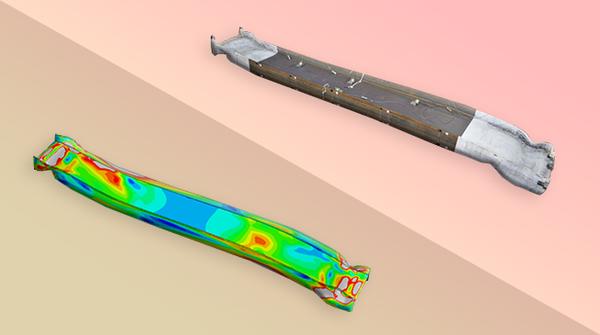Earthquake engineering: an EPFL laboratory stands out

© RESSlab / EPFL 2018
Three researchers from the Resilient Steel Structures Laboratory (RESSlab) beat 11 other teams to win an international computer simulation contest on earthquake engineering. They will present their work on 13 April at a conference in Baltimore (USA).
EPFL’s Resilient Steel Structures Laboratory (RESSlab) finished in first place in the comprehensive category at an international computer simulation competition on earthquake engineering: the NIST-ATC Blind Prediction Contest 2018. The RESSlab team developed the most accurate numerical model, as measured by 11 criteria, predicting the deformation of three steel columns subjected to earthquake loading. The researchers will receive their prize and present their work on 13 April at a special session dedicated to the blind analysis prediction contest as part of the AISC Steel Conference (NASCC) in Baltimore.
These contests are blind because the researchers receive only partial information on a structure or component. Using just the geometry and the imposed load conditions, the EPFL researchers were able to demonstrate with a high level of accuracy that it is possible to simulate material and geometric instabilities in steel components undergoing cyclic loading similar to that of an earthquake.
“We used simulation models and a methodology that we developed in the scope of a research project financed by the Swiss National Science Foundation (SNSF),” says Dimitrios Lignos, an associate professor and director of RESSlab. “The aim of this project is to use computer simulations validated by carefully designed physical experiments to deepen our understanding of the complex deterioration processes associated with geometric instabilities observed in steel structures as a result of earthquake-induced loading. We plan to share these tools with the scientific community.” For Lignos, the results of this competition also serve to highlight EPFL’s internationally recognized expertise in computer modeling across scales.
 Thanks to RESSlab’s models, researchers can also forecast the dynamic behavior of steel buildings subjected to earthquakes of different magnitudes and predict if these buildings would suffer major deterioration in strength and stiffness. The researchers plan to publish an article about their method soon.
Thanks to RESSlab’s models, researchers can also forecast the dynamic behavior of steel buildings subjected to earthquakes of different magnitudes and predict if these buildings would suffer major deterioration in strength and stiffness. The researchers plan to publish an article about their method soon.
The column simulation modelised by the lab. © RESSlab / EPFL 2018
While he was working at McGill University in Montreal, Lignos and his research group won two other blind prediction contests. With funding from the SNSF, Lignos and his team are also planning to organize their own blind prediction contest, looking at a two-story steel structure that will be tested in EPFL’s Structures Laboratory in 2019.
The EPFL team, comprising Alexander Hartloper, a PhD student, and Ahmed Elkady, a post-doc, was led by Lignos Dimitrios, the director of RESSlab. They won the blind analysis competition over 11 other teams from around the world, coming in just ahead of Pennsylvania State University. Thornton Tomasetti, a civil engineering firm based in Chicago, won top honors in the simple category. The International Blind Analysis Contest is run by two US-based organizations: the National Institute of Standards and Technology (NIST) and the Applied Technology Council (ATC).